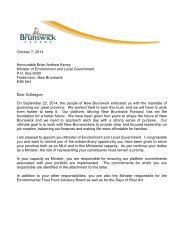cbd-ts-67-en
cbd-ts-67-en
cbd-ts-67-en
- No tags were found...
You also want an ePaper? Increase the reach of your titles
YUMPU automatically turns print PDFs into web optimized ePapers that Google loves.
Section 1: Impac<strong>ts</strong> of marine debris on biodiversity<br />
A total of 85 taxa were id<strong>en</strong>tified in this report, tak<strong>en</strong> from 6 papers which described the use of marine debris<br />
as habitat (Table 4). Four of the papers (Carr et al., 1985; Donohue et al., 2001; Ayaz et al., 2006; Good et al.,<br />
2010) reported species colonizing derelict fishing ne<strong>ts</strong> as habitat. These included both mobile and sessile species.<br />
Pace et al., (2007), reported the use of marine debris as habitat in the Maltese Islands, including plastics, glass,<br />
pottery, metals and sacks and id<strong>en</strong>tified 47 associated species (listed under unknown in Table 4 as no species<br />
list was included).<br />
TABLE 4: Number of taxa and number of papers by taxonomic group that report the use of marine debris as a habitat. Unknown<br />
repres<strong>en</strong><strong>ts</strong> those species id<strong>en</strong>tified by Pace et al., 2007 as no species list was pres<strong>en</strong>ted.<br />
Taxonomic group Number of taxa Number of papers<br />
Bivalves 1 1<br />
Bryozoans 1 1<br />
Cephalopods 1 1<br />
Cnidaria 3 2<br />
Crustaceans 14 3<br />
Echinoderms 6 3<br />
Fish 10 1<br />
Gastropods 1 1<br />
Pelagic Insec<strong>ts</strong> 1 1<br />
Polycheates 2 1<br />
Porifera 1 1<br />
Seagrass & Algae 2 1<br />
Unknown 47 1<br />
In deep water sedim<strong>en</strong>tary habita<strong>ts</strong>, Pace et al., (2007) found a greater abundance of taxa on debris than the<br />
surrounding sedim<strong>en</strong>t, but greater species richness on the sedim<strong>en</strong>t. The assemblage structure differed, however,<br />
with the debris increasing overall diversity of species pres<strong>en</strong>t within the area sampled. There are also refer<strong>en</strong>ces<br />
to floating debris such as microplastic providing a habitat for microorganisms. It has be<strong>en</strong> suggested that some<br />
microorganisms might use plastic as a food source leading to biodegradation of debris (PlasticsEurope.org, 2010).<br />
While there are repor<strong>ts</strong> of biodegradation of compostable plastics (Song et al., 2009; O’Brine & Thompson, 2010),<br />
there are no peer reviewed articles docum<strong>en</strong>ting biodegradation for conv<strong>en</strong>tional plastics. Some species of Vibrio<br />
bacteria have be<strong>en</strong> shown to grow prefer<strong>en</strong>tially on plastic debris in the ocean, but it is unknown whether those<br />
found are pathog<strong>en</strong>ic. Harrison et al., (2011) suggest that microbes may raft on marine debris, causing concern<br />
as they are the causative ag<strong>en</strong><strong>ts</strong> of disease for corals.<br />
An area of growing interest is the pot<strong>en</strong>tial for accumulated buoyant debris, such as plastic items and microplastic<br />
fragm<strong>en</strong><strong>ts</strong>, to provide new habita<strong>ts</strong> in the op<strong>en</strong> ocean. Goldstein et al., (2012) determined that the conc<strong>en</strong>tration<br />
of microplastics within the North Pacific C<strong>en</strong>tral Gyre had increased by two orders of magnitude in the past<br />
four decades. Similarly, Law et al., (2010) showed that the greatest abundance of debris in subtropical locations<br />
was far from land, and in a study of the north western Mediterranean, Collingnon et al., (2012) estimated the<br />
mean abundance of microplastics to be the same order of magnitude as that found by Moore et al., (2001) within<br />
the North Pacific Gyre (1.334 particles m -2 ). The surfaces of debris items within these systems are available for<br />
colonization, thus increasing the pot<strong>en</strong>tial for transport of organisms on marine debris. At the same time, this<br />
debris can provide a novel habitat for mobile organisms.<br />
21



